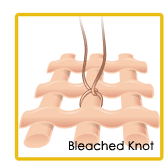What are Frontal Lace Wigs?
(and other lace frontal wig questions)
"What are frontal lace wigs?"
Firstly, you're not alone. We get a ton of questions asking about frontal lace wigs, lace frontal wigs, lace wig frontals, lace frontals, lace fronts, full lace frontal... You can see where we're going with this, right?
It's a bit odd really because there are scores of websites out there selling lace wigs in all the possible guises and yet don't provide enough clear information to allow actual and potential wearers to understand the correct names and different types of lace cap hairpieces; well help is at hand, let's get to it (or at least let's get to what we think you mean by "frontal lace wigs"...wigs with lace at the front, also called lace front wigs).

In general, lace wigs in don't use the traditional style of wig cap; instead the wig cap uses lace all over or just at the front hairline.
It's because of the lace at the front that many people use the terms front and frontals when referring to lace wigs (lace frontals are actually similar to toupees in that they are not full wigs, they are just used to act as weave closure, or as a hair replacement system for those who have lost their hair or the hair has thinned at the front of the head)
There are several types of lace used for lace wigs and lace frontals and lace fronts and if you like, frontal lace wigs.
- Swiss Lace
- Super Fine Swiss Lace
- French Lace
- Nylon - sometimes used for lace wigs that don't require glue "glueless" (not a real word, we know!)
The lace is so thin that it appears to "disappear" when placed against the skin. Single (individual) strands of hair are ventilated (think crochet) into the lace cap so that the hair appears to be growing directly from the scalp - this feature makes lace wigs (or if you prefer "frontal lace wigs") exceptionally appealing.
In order to add to the appearance of natural hair veracity, many lace wigs and lace frontals and lace front wigs have significantly shorter hairs used at the very front of the hairline to mimic “baby” hairs. This also has the benefit of camouflaging the lace further.
"Do frontal lace wigs have bleached knots?"
Not always. It's always best to check the listing description from your chosen retailer to find out if the knots are bleached.
Usually knots are only bleached at the front hairline and although we say "hairline", the bleaching is usually anywhere between 2-5 cm deep towards the crown.

In the olden days (say around... 2005) bleached knots were a staple of lace wigs. Manufacturers routinely bleached knots as many wearers who wore darker colours were conscious that little dark dots (where the strands of hair had been knotted to the lace) would make it obvious that they were wearing a wig.
However bleaching knots created another problem; shedding.
The fact is, when you apply bleach (ammonia) to human hair (whether on a wig or on your head) you weaken the structure of the hair.
That's science fact and not marketing fiction.
As it was just the knots that were subject to bleach (ammonia), the lace knotted strands of hair were weakened which meant that the hair knot had a tendency to become dry and brittle and break easily; or in wig terms... shed.
Whoa!! Before you go to bed and have nightmares about whole chunks of hair disappearing from your lace wig, we want to emphasise two things:
- All wigs shed hair (including non-lace cap wigs, and irrespective of whether they are human hair wigs or synthetic hair wigs).
- Shedding is a gradual process.
What tends to happen with bleached knots is that the rate of shedding is quicker than the rate of shedding everywhere else on the wig where the knots are haven't been bleached.
"What should you do if frontal lace wigs don't have bleached knots?"
If your lace front wig or lace frontal doesn't have bleached knots, you can lighten the colour the knots yourself using a blonde hair dye
Be warned however that even though the dye is applied to the inside of the lace wig cap, some of the dye can travel up the hair strands so that when you put the wig on, you're likely to have what some folks affectionately call "hot roots" (where the colour of the hair strand that is closest to the lace cap is lighter in colour than the rest of the hair strands).
Alternatively you can use a concealer or foundation along the hairline or parting.
The thing to remember here is that other people don't examine our faces or hairlines with the same microscopic scrutiny that we do. Most people automatically assume the hair on your head is growth hair and it's only when it looks significantly unnatural that they begin to look a little harder.
"Are there synthetic frontal lace wigs?"
There certainly are. Synthetic lace front wigs have been around for some time now and are more affordable that human hair lace front wigs. Some versions of synthetic lace wigs are heat resistant whilst other aren't; so always, always, always check this with your chosen retailer.
We can't tell you how many times we've had people ask us what they can do to "repair" their synthetic lace wig that melted and matted when they used curling irons because they thought all synthetic hair was heat resistant... (Oh, and the answer to that question is you cannot do a thing except cut off the melted-matted part of the hair).
Jump from Frontal Lace Wigs to Q&A Page
Jump From Frontal Lace Wigs to Home Page




